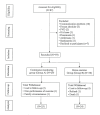Effects of a Cardiac Telerehabilitation Program on the Quality of Life and Functional Independence of Patients With Coronary Artery Bypass Graft: A Non-randomized Controlled Trial
- PMID: 40062015
- PMCID: PMC11887514
- DOI: 10.7759/cureus.78548
Effects of a Cardiac Telerehabilitation Program on the Quality of Life and Functional Independence of Patients With Coronary Artery Bypass Graft: A Non-randomized Controlled Trial
Abstract
Background: The most common surgical approach for the treatment of coronary artery disease is coronary artery bypass graft (CABG), and it helps to lower mortality and morbidity. Cardiac rehabilitation (CR) is a systematic approach for improving patients' physical and functional abilities. It also helps promote independence and reduce the rate of hospital readmissions. Following surgery, there is a relatively low referral rate for CR, and compliance is much more of an issue. Increasing involvement in CR can be achieved by cardiac telerehabilitation. Thus, this study aims to evaluate how cardiac telerehabilitation affects functional independence and quality of life in patients with CABG.
Methods: A non-randomized controlled trial was conducted in a multispecialty hospital for four years in which a total of 49 consecutive CABG patients were recruited and divided into a cardiac telerehabilitation (25 patients, including 12 males and 13 females) and home exercise group (24 patients, including eight males and 16 females) through purposive sampling based on their ability to use audio-visual aid and participate in cardiac telerehabilitation. Functional independence was assessed with the Functional Independence Measure (FIM) scale and quality of life was measured with the Short Form-36 (SF-36) scale at discharge, one month, and three months post discharge.
Results: The mean FIM score of group A was 107.40 (4.72) and group B was 105.92 (2.60), whereas the mean SF-36 score of group A was 35.61 (6.36) and group B was 31.59 (5.18). At three months post discharge, patients in the cardiac telerehabilitation group showed statistically significant improvement in functional status (p = 0.033 at one month and p = 0.019 at three months post cardiac telerehabilitation) and quality of life (p = 0.001 at three months post cardiac telerehabilitation).
Conclusion: Cardiac telerehabilitation is beneficial for patients with CABG, improving their daily living and quality of life if they are unable to attend center-based CR.
Keywords: activities of daily living (adls); cardiac telerehabilitation; coronary artery bypass graft (cabg); exercise program; functional status; quality of life (qol).
Copyright © 2025, Kalpesh et al.
Conflict of interest statement
Human subjects: Consent for treatment and open access publication was obtained or waived by all participants in this study. Sumandeep Vidyapeeth Institutional Ethics Committee (SVIEC) issued approval SVIEC/ON/PHYS/PHD/12016. Animal subjects: All authors have confirmed that this study did not involve animal subjects or tissue. Conflicts of interest: In compliance with the ICMJE uniform disclosure form, all authors declare the following: Payment/services info: All authors have declared that no financial support was received from any organization for the submitted work. Financial relationships: All authors have declared that they have no financial relationships at present or within the previous three years with any organizations that might have an interest in the submitted work. Other relationships: All authors have declared that there are no other relationships or activities that could appear to have influenced the submitted work.
Figures



References
-
- Cardiovascular diseases in India: current epidemiology and future directions. Prabhakaran D, Jeemon P, Roy A. Circulation. 2016;133:1605–1620. - PubMed
-
- Summary of American Heart Association diet and lifestyle recommendations revision 2006. Lichtenstein AH, Appel LJ, Brands M, et al. Arterioscler Thromb Vasc Biol. 2006;26:2186–2191. - PubMed
-
- Functional status of patients during subacute recovery from coronary artery bypass surgery. LaPier TK. Heart Lung. 2007;36:114–124. - PubMed
LinkOut - more resources
Full Text Sources
